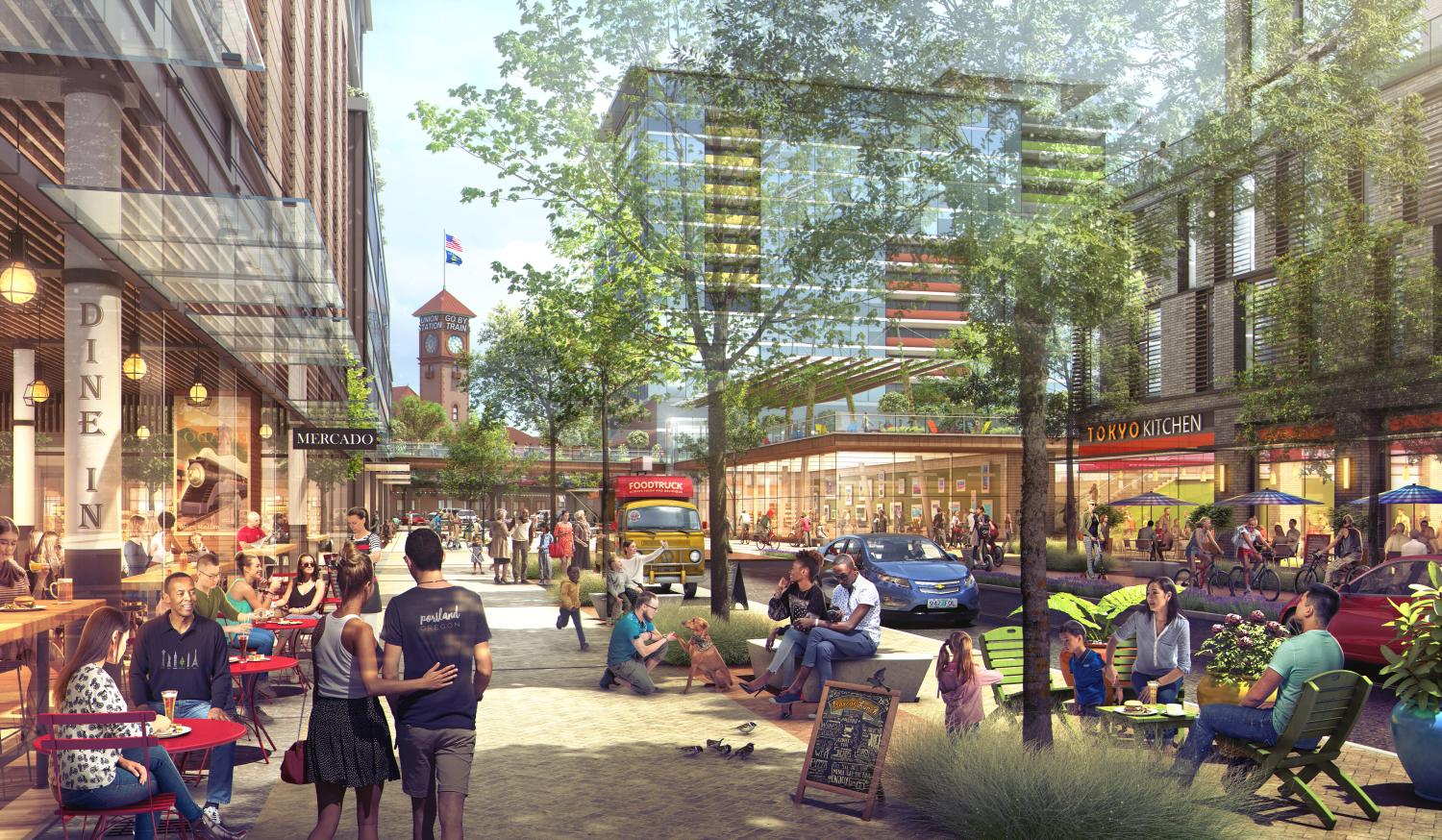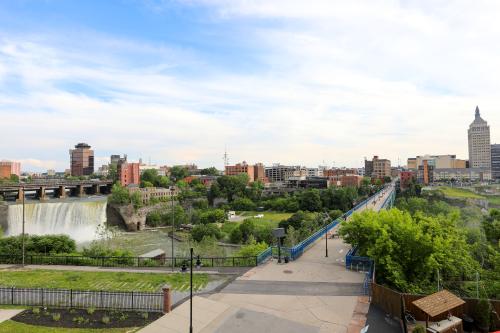Placemaking Postcards is a blog series from the Bass Center for Transformative Placemaking at Brookings where policymakers and practitioners guest-author promising placemaking efforts from across the U.S. and abroad that foster connected, vibrant, and inclusive communities. In line with the principle tenets of placemaking, the goal of the series is to recognize the community as the expert, highlight voices from the field, and to create a community of learning and practice around transformative placemaking.
It’s been over a year since calls for anti-racist urban policies echoed in cities around the country. It was in this context—in the middle of a starkly inequitable pandemic, Black Lives Matter protests, and white supremacist counterprotests in Portland, Ore.—that a broad-based coalition of residents, activists, nonprofit leaders, public officials, and a private developer crafted an unprecedented community benefits agreement (CBA) for a 32-acre redevelopment project north of downtown.
The culmination of years of planning (and still with some legal and implementation hurdles to overcome), the CBA prioritizes racial equity, delivering good jobs, and benefiting working class residents. It represents an opportunity for the city to redress many of the injustices experienced by communities of color with long ties to the area—including Japanese and Chinese American, African American, and Native American families who had been systematically expelled from the Central City—and promote what could be a national model for more equitable public-private large-scale development.
Laying the groundwork for a more equitable development process
It is no accident that Portland is known as the “whitest” big city in America. When the Oregon Territory entered the union in 1859, Black people were prohibited from living within its borders. During much of the 20th century, redlining, exclusionary zoning, and displacement pushed African Americans and other communities of color to the outer fringes of the city, where many still live today. Despite the city’s efforts over the past 30 years to address racial disparities through planning, rezoning, and fair housing policies, many residents continue to feel left out of the development process and priced out of new neighborhoods.
Beginning in 2015, the mayor and city council began to shift the focus of the city’s economic and urban development agency—renaming it Prosper Portland—to center equitable development goals. By this time, more than 20 local organizations representing people of color, environmental justice, small businesses, people with disabilities, and organized labor had already been working together to create a united front to shape development in their city. According to Vivian Satterfield, director of strategic partnerships for the nonprofit Verde and a lead negotiator of the eventual CBA, these community organizations spent years engaging in “deep relationship-building” to found the Healthy Communities Coalition (HCC) in 2015. Their goal was to ensure new development projects delivered jobs, quality housing, and other opportunities for the people they represented.
They got their first chance in 2017, when Prosper Portland and the Portland Housing Authority acquired a U.S. Postal Service regional processing facility across from historic Union Station, in the Central City. The City Council and Prosper Portland saw an opportunity to address many of its equitable economic development goals through the disposition of the site and another 20 acres of the Broadway Corridor around it.
The city wanted to transform the Broadway Corridor into a dense new neighborhood “that directly benefited those who have historically been most harmed and have benefited the least from these kinds of major public-private partnerships,” according to Prosper Portland Executive Director Kimberly Branam. At the same time, the HCC viewed the project as their first opportunity to test out their new “movement for economic justice,” and reached out to the city to make sure they had a major voice in the process.

The slow work of testing equitable development on the ground
Prosper Portland convened a remarkably diverse steering committee—largely comprised of representatives of low-income and underserved communities and workers—to co-create the goals for the project and the master plan for the site, advise on the selection of a private developer, and craft an inclusive community engagement strategy. The HCC was well represented on the committee and was invited to negotiate the CBA with Prosper Portland and Continuum Partners (the private developer selected for the project). Prosper Portland’s efforts to prioritize underserved communities and workers in the planning process—as well as six months of exploratory conversations before they even got to the negotiating table—helped the parties build the trust needed to deal with thorny issues along the way.
|
Placemaking and the Broadway Corridor To ensure the planning process engaged a diverse group of community members, the Broadway Corridor Steering Committee and Prosper Portland hired Project for Public Spaces in 2018 to work with the master planning team, led by ZGF Architects, to design a community engagement effort that would reach residents who had been historically excluded from planning processes. These engagement activities consisted of public meetings and open houses, pop-up events, 22 Steering Committee meetings open to the public, online forums, surveys, and focus groups in which over 1,000 people from all over Portland provided meaningful input, with a disproportionately high participation of people of color. The public’s recommendations were largely taken into account in the master plan and the CBA. |

The planning process was not without challenges. In stakeholder interviews, some members of the HCC mentioned that the coalition—and consequently, the Steering Committee—was not truly balanced, with organized workers possessing more resources and experience to ensure their demands were heard than representatives of low-income neighborhoods. Additionally, Marcus Mundy, executive director of the Coalition of Communities of Color, a member of the HCC, noted that environmental justice and green jobs were less of a priority for the city, the developer, and the labor unions than for many of the other HCC members. In response, Prosper Portland Executive Director Branam suggested that shoring up the capacity of the less-experienced organizations and giving them an equal footing could be a potential role for public partners and foundations moving forward.
Forging a different kind of community benefits agreement
For over 20 years, CBAs have provided low-income communities with the means to obtain living wages, local hiring commitments, and other community economic benefits from developers of large-scale projects. In addition to the broad representation of underserved communities from Portland and a commitment to racial equity, what makes the Broadway Corridor CBA different from most is that it is not a “public works” project built solely with major public subsidies, but instead a public-private partnership funded primarily through private investment.
In September 2020, the Portland City Council signed the terms of the agreement, which stipulate the creation of 8,800 new jobs prioritizing people of color and women (30% people of color and 15% women), the provision of workforce development funds in the construction and operation phases, and stipulations that affordable housing will comprise approximately 30% of the total units (both through the Portland Housing Authority and a 10% inclusionary requirement for private developers). Prosper Portland committed to providing grants and low-cost loans to support affordable commercial space, prioritizing businesses owned by people of color and with disabilities. The CBA also outlines sustainability goals, including carbon neutrality and an all-renewable energy strategy.
The legal document is not yet signed, but the terms in the Development and Disposition Agreement stipulate that to ensure the CBA is carried out for at least the next 10 years, members of the HCC and others will establish a mechanism for oversight and monitoring of the agreement’s terms. As the Coalition of Communities of Color’s Marcus Mundy points out, it is one thing to have negotiated an agreement, but another to ensure that it is implemented. Time will tell if the Oversight Committee will be able to exercise the control that is envisioned and enforce the terms once construction is underway and after the development is built.
While the CBA for this immense public-private project will likely face many challenges in the future (and many residents believe it could have gone further in its scope), this once-in-a-generation opportunity is still raising the bar for equitable and sustainable development. No one project can reverse decades of discrimination and racial injustice, but if the Broadway Corridor lives up to its potential as an inclusive place, it will be a living demonstration of the power of real commitments to equity and the remarkable partnerships that were embraced to achieve it.




![[picture courtesy of PPS] Meg Walker, senior vice president at Project for Public Spaces](https://www.brookings.edu/wp-content/uploads/2017/04/meg_walker_2.jpg?quality=75&w=250)



Commentary
How a diverse coalition in Portland, Ore. is centering racial equity in a large-scale development project
July 12, 2021